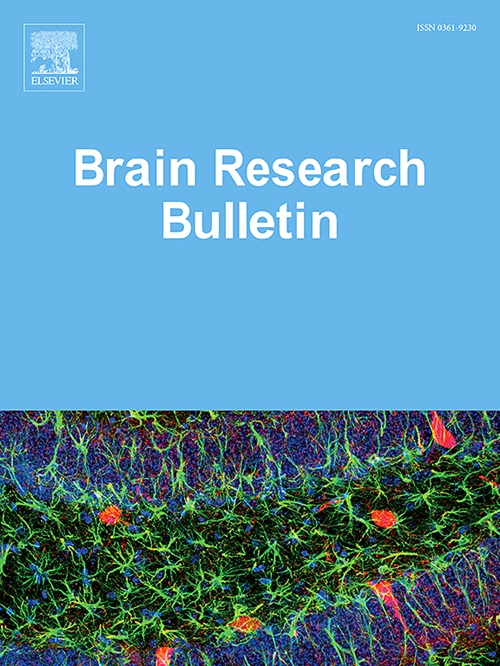在实验性神经病大鼠模型中,α2-肾上腺素受体间接参与了脊髓给药咪唑啉 I1 受体配体 LNP599 诱导的机械抗过敏效应
IF 3.5
3区 医学
Q2 NEUROSCIENCES
引用次数: 0
摘要
在此,我们评估了脊髓给药咪唑啉 I1 受体激动剂 LNP599 是否会减弱神经病理性痛超敏反应,以及这种减弱是否涉及 α2-肾上腺素受体的共同激活。使用神经损伤(SNI)模型诱导雄性和雌性大鼠对机械过敏,并使用慢性导管进行鞘内给药。对受伤肢体的机械敏感性和热痛觉进行了行为学评估。此外,还利用 GTPγS 放射配体结合试验、β-arrestin 招募和细胞内 cAMP 水平进行体外受体分析。LNP599(咪唑啉 I1 受体激动剂)和氯尼丁(α2-肾上腺素受体激动剂)对男女产生了相同剂量相关的机械抗过敏效应。LNP599 可优先减轻雄性动物的热痛觉,而氯尼替丁可同样减轻雄性动物和雌性动物的热痛觉。Carbophenyline(另一种咪唑啉 I1 受体激动剂)对雄性或雌性的机械过敏性或热痛觉均无明显影响。用育亨宾或阿替巴唑(两种α2-肾上腺素受体拮抗剂)进行预处理可阻止 LNP599 在 SNI 雄性动物中诱导的机械抗过敏性和热抗痛性,但用依法罗生(一种咪唑啉 I1 受体/α2-肾上腺素受体混合拮抗剂)则无法阻止。体外试验表明,LNP599 不会激活 α2A- 或其他亚型的 α2-肾上腺素受体。然而,LNP599 是 5-HT2B 受体的弱部分激动剂,并与 sigma-1 和 sigma-2 受体结合,这些受体都参与脊髓痛觉的调节。结果表明,LNP599 对神经性痛觉过敏的抑制作用不是由于对脊髓咪唑啉 I1 受体的作用,而是由于间接激活了脊髓 α2-肾上腺素受体。本文章由计算机程序翻译,如有差异,请以英文原文为准。
Indirect involvement of α2-adrenoceptors in the mechanical antihypersensitivity effect induced by the spinally administered imidazoline I1 receptor ligand LNP599 in a rat model of experimental neuropathy
Here we assess whether neuropathic pain hypersensitivity is attenuated by spinal administration of the imidazoline I1-receptor agonist LNP599 and whether the attenuation involves co-activation of α2-adrenoceptors. Spared nerve injury (SNI) model of neuropathy was used to induce mechanical hypersensitivity in male and female rats with a chronic catheter for intrathecal drug administrations. Mechanical sensitivity and heat nociception were assessed behaviorally in the injured limb. Additionally, GTPγS radioligand binding assay, β-arrestin recruitment and intracellular cAMP levels were used for receptor profiling in vitro. LNP599 (imidazoline I1 receptor agonist) and clonidine (α2-adrenoceptor agonist) produced equal dose-related mechanical antihypersensitivity effects in both sexes. LNP599 attenuated heat nociception preferentially in males, while clonidine reduced heat nociception equally in males and females. Carbophenyline (another imidazoline I1 receptor agonist) had no significant effect on mechanical hypersensitivity or heat nociception in males or females. Mechanical antihypersensitivity and heat antinociception induced by LNP599 in SNI males was prevented by pretreatments with yohimbine or atipamezole (two α2-adrenoceptor antagonists) but not by efaroxan (a mixed imidazoline I1 receptor/α2-adrenoceptor antagonist). In vitro assays indicated that LNP599 does not activate α2A- or other subtypes of α2-adrenoceptors. However, LNP599 was a weak partial agonist for 5-HT2B receptors and bound to sigma-1 and sigma-2 receptors that all are involved in modulation of spinal nociception. The results indicate that the suppression of neuropathic pain hypersensitivity by LNP599 is not due to action on spinal imidazoline I1 receptors, but rather due to indirect activation of spinal α2-adrenoceptors.
求助全文
通过发布文献求助,成功后即可免费获取论文全文。
去求助
来源期刊

Brain Research Bulletin
医学-神经科学
CiteScore
6.90
自引率
2.60%
发文量
253
审稿时长
67 days
期刊介绍:
The Brain Research Bulletin (BRB) aims to publish novel work that advances our knowledge of molecular and cellular mechanisms that underlie neural network properties associated with behavior, cognition and other brain functions during neurodevelopment and in the adult. Although clinical research is out of the Journal''s scope, the BRB also aims to publish translation research that provides insight into biological mechanisms and processes associated with neurodegeneration mechanisms, neurological diseases and neuropsychiatric disorders. The Journal is especially interested in research using novel methodologies, such as optogenetics, multielectrode array recordings and life imaging in wild-type and genetically-modified animal models, with the goal to advance our understanding of how neurons, glia and networks function in vivo.
 求助内容:
求助内容: 应助结果提醒方式:
应助结果提醒方式:


